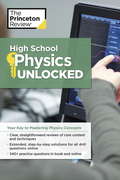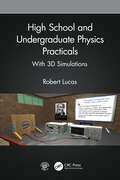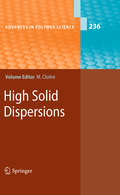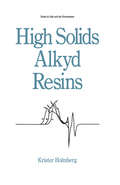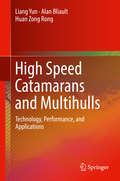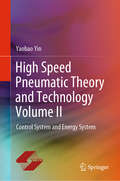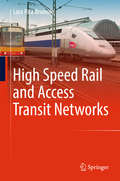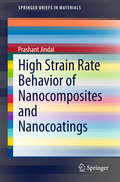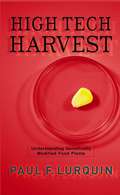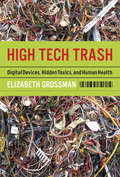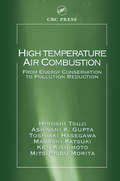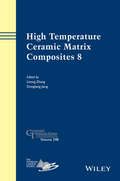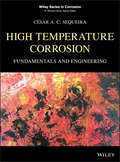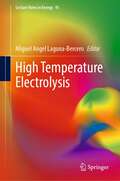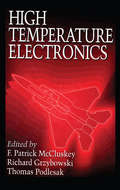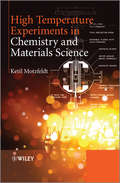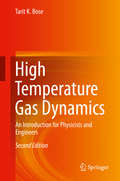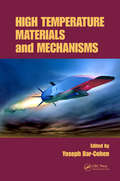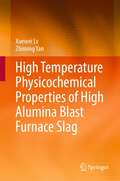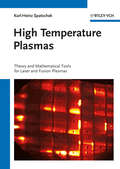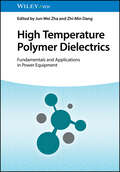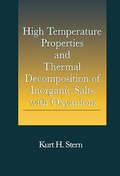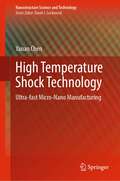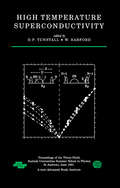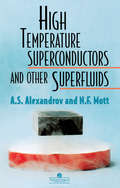- Table View
- List View
High School Physics Unlocked: Your Key to Understanding and Mastering Complex Physics Concepts
by Princeton ReviewUNLOCK THE SECRETS OF PHYSICS with THE PRINCETON REVIEW.High School Physics Unlocked focuses on giving you a wide range of key lessons to help increase your understanding of physics. With this book, you'll move from foundational concepts to complicated, real-world applications, building confidence as your skills improve. End-of-chapter drills will help test your comprehension of each facet of physics, from mechanics to magnetic fields. Don't feel locked out!Everything You Need to Know About Physics.* Complex concepts explained in straightforward ways* Clear goals and self-assessments to help you pinpoint areas for further review* Bonus chapter on modern physicsPractice Your Way to Excellence.* 340+ hands-on practice questions in the book and online* Complete answer explanations to boost understanding, plus extended, step-by-step solutions for all drill questions online* Bonus online questions similar to those you'll find on the AP Physics 1, 2, and C Exams and the SAT Physics Subject TestHigh School Physics Unlocked covers:* One- and Multi-dimensional Motion* Forces and Mechanics* Energy and Momentum* Gravity and Satellite Motion* Thermodynamics* Waves and Sound* Electric Interactions and Electric Circuits* Magnetic Interactions* Light and Optics... and more!From the Trade Paperback edition.
High School and Undergraduate Physics Practicals: With 3D Simulations
by Robert LucasThis book describes more than thirty physics practicals at high school and undergraduate levels with background information on each one, a description of the equipment needed, and instructions on how the experiment is performed. Uniquely, for those without access to a real laboratory, the book provides access to highly detailed 3D simulations of all the experiments. The simulations are a superset of the Virtual Physics Laboratory as reviewed and given the Green Tick of Approval by the Association for Science Education. They run in any browser that supports WebGL, such as Microsoft Edge or Firefox on Windows and Safari on Mac. For the school or university student who wants to practice and widen their knowledge of physics, or for those who are learning on their own, this is an ideal book for honing and broadening experimental skills. The simulations are the result of many years researching the teaching of online science, a field in which the author has published many papers.
High Solid Dispersions
by Michel CloitreFrom Polymers to Colloids: Engineering the Dynamic Properties of Hairy Particles, by D. Vlassopoulos and G. Fytas * Nonlinear Rheological Properties of Dense Colloidal Dispersions Close to a Glass Transition Under Steady Shear, by M. Fuchs * Micromechanics of Soft Particle Glasses, by R. T. Bonnecaze and M. Cloitre * Quantitative Imaging of Concentrated Suspensions Under Flow, by L. Isa, R. Besseling, A. B. Schofield and W. C. K. Poon * Soft and Wet Materials: From Hydrogels to Biotissues, by J. P. Gong and Y. Osada
High Solids Alkyd Resins
by K. HolmbergThis book covers the chemistry of high solids compositions and focuses on the binder component and on the solvent. It discusses factors controlling the viscosity and the solid content of alkyd resins. The book describes different approaches to preparing high solid alkyds.
High Speed Catamarans and Multihulls: Technology, Performance, And Applications
by Alan Bliault Liang Yun Huan Zong RongHigh speed catamaran and multihull high speed marine vessel have become very popular in the last two decades. The catamaran has become the vessel of choice for the majority of high speed ferry operators worldwide. There have been significant advances in structural materials, and structural design has been combined with higher power density and fuel efficient engines to deliver ferries of increasing size. The multihull has proven itself to be a suitable configuration for active power projection across oceans as well as for coastal patrol and protection, operating at high speedd for insertion or retrieval with a low energy capability. At present there is no easily accessible material covering the combination of hydrodynamics, aerodynamics, and design issues including structures, powering and propulsion for these vehicles. Coverage in High Speed Catamarans and Multihulls includes an introduction to the history, evolution, and development of catamarans, followed by a theoretical calculation of wave resistance in shallow and deep water, as well as the drag components of the multihull. A discussion of vessel concept design describing design characteristics, empirical regression for determination of principal dimensions in preliminary design, general arrangement, and methods is also included. The book concludes with a discussion of experimental future vehicles currently in development including the small waterplane twin hull vessels, wave piercing catamarans, planing catamarans, tunnel planing catamarans and other multihull vessels.
High Speed Pneumatic Theory and Technology Volume II: Control System and Energy System
by Yaobao YinThis book highlights the latest developments and the author’s own research achievements in high speed pneumatic control theory and applied technology. Chiefly focusing on the control system and energy system, it presents the basic theory and pioneering technologies for aerospace and aviation, while also addressing e.g. pneumatic servo control theory, pneumatic nonlinear mechanisms, aerothermodynamics, pneumatic servo mechanisms, and sample applications of high temperature and high speed gas turbine systems in aerospace, aviation, and major equipment.
High Speed Rail and Access Transit Networks
by Lara Rita BrunelloThis book examines the promise of High Speed Rail (HSR) technologies to win market share from carbon-intensive air transport through the strategic optimization of rail productivity and efficiency. While the positive impacts of HSR at both urban and long-distance levels are well-documented, this resource focuses on what has been a challenging area for HSR deployment historically: the integration of HSR accessibility at the regional level. The author provides tools and methods to better measure the feasibility of integrating regional HSR with existing transport networks, and includes in-depth case studies to demonstrate the contributions of expanded high speed rail access on sustainable development.Shares options for maximizing efficiency and effectiveness of high speed rail transport;Compares strategies for integrating urban, long-distance, and regional high speed rail transport;Explores new dimensions of high speed rail deployment by linking transit networks with increased regional accessibility.
High Strain Rate Behavior of Nanocomposites and Nanocoatings
by Prashant JindalThis book describes the use of multiwall carbon nanotubes as composites with polycarbonates and as protective coatings on glass surfaces. The book explains fabrication and characterization methods for these composites and coatings. The author reports on the use of Split Hopkinson Pressure Bar set up for evaluating the dynamic strength of these composites and coatings and studying the role of carbon nanotubes in the enhancement of their dynamic strength.
High Tech Harvest: Understanding Genetically Modified Food Plants
by Paul F. LurquinGenetically engineered plant products line the shelves of our grocery stores, but we don't know which ones they are because no label identifies them. Should we be concerned? It is true that biotech companies are saying that engineered corn and canola are safe, but are they telling the truth? In High Tech Harvest, Paul Lurquin answers these questions and more, believing that the public has a right to know and understand how its food is manipulated at the most basic level, that of the DNA itself. With the goal to inform, and a mission to reinforce the importance of the scientific method, Paul Lurquin writes a comprehensive and user-friendly description of the scientific origins, the development, and the applications of genetically modified plants throughout the world today. Lurquin argues that only with an understanding of the basic science can people make informed and reasonable decisions about genetically modified foods.
High Tech Trash: Digital Devices, Hidden Toxics, and Human Health
by Elizabeth GrossmanThe Digital Age was expected to usher in an era of clean production, an alternative to smokestack industries and their pollutants. But as environmental journalist Elizabeth Grossman reveals in this penetrating analysis of high tech manufacture and disposal, digital may be sleek, but it's anything but clean. Deep within every electronic device lie toxic materials that make up the bits and bytes, a complex thicket of lead, mercury, cadmium, plastics, and a host of other often harmful ingredients.High Tech Trash is a wake-up call to the importance of the e-waste issue and the health hazards involved. Americans alone own more than two billion pieces of high tech electronics and discard five to seven million tons each year. As a result, electronic waste already makes up more than two-thirds of the heavy metals and 40 percent of the lead found in our landfills. But the problem goes far beyond American shores, most tragically to the cities in China and India where shiploads of discarded electronics arrive daily. There, they are "recycled"-picked apart by hand, exposing thousands of workers and community residents to toxics.As Grossman notes, "This is a story in which we all play a part, whether we know it or not. If you sit at a desk in an office, talk to friends on your cell phone, watch television, listen to music on headphones, are a child in Guangdong, or a native of the Arctic, you are part of this story."The answers lie in changing how we design, manufacture, and dispose of high tech electronics. Europe has led the way in regulating materials used in electronic devices and in e-waste recycling. But in the United States many have yet to recognize the persistent human health and environmental effects of the toxics in high tech devices. If Silent Spring brought national attention to the dangers of DDT and other pesticides, High Tech Trash could do the same for a new generation of technology's products.
High Temperature Air Combustion: From Energy Conservation to Pollution Reduction
by Hiroshi Tsuji Ashwani K. Gupta Toshiaki Hasegawa Masashi Katsuki Ken Kishimoto Mitsunobu MoritaMaximize efficiency and minimize pollution: the breakthrough technology of high temperature air combustion (HiTAC) holds the potential to overcome the limitations of conventional combustion and allow engineers to finally meet this long-standing imperative. Research has shown that HiTAC technology can provide simultaneous reduction of CO2 and nitric
High Temperature Ceramic Matrix Composites 8
by Litong Zhang Dongliang JiangThis proceedings contains 78 papers from the 8th International Conference on High Temperature Ceramic Matrix Composites, held September 22-26, 2013 in Xi'an, Shaanxi, China. Chapters include: Ceramic Genome, Computational Modeling, and Design Advanced Ceramic Fibers, Interfaces, and Interphases Nanocomposite Materials and Systems Polymer Derived Ceramics and Composites Fiber Reinforced Ceramic MatrixComposites Carbon-Carbon Composites: Materials, Systems, and Applications Ultra High Temperature Ceramics and MAX Phase Materials Thermal and Environmental Barrier Coatings
High Temperature Corrosion: Fundamentals and Engineering (Wiley Series in Corrosion)
by César A. SequeiraReviews the science and engineering of high-temperature corrosion and provides guidelines for selecting the best materials for an array of system processes High-temperature corrosion (HTC) is a widespread problem in an array of industries, including power generation, aerospace, automotive, and mineral and chemical processing, to name a few. This book provides engineers, physicists, and chemists with a balanced presentation of all relevant basic science and engineering aspects of high-temperature corrosion. It covers most HTC types, including oxidation, sulfidation, nitridation, molten salts, fuel-ash corrosion, H2S/H2 corrosion, molten fluoride/HF corrosion, and carburization. It also provides corrosion data essential for making the appropriate choices of candidate materials for high-temperature service in process conditions. A form of corrosion that does not require the presence of liquids, high-temperature corrosion occurs due to the interaction at high temperatures of gases, liquids, or solids with materials. HTC is a subject is of increasing importance in many areas of science and engineering, and students, researchers, and engineers need to be aware of the nature of the processes that occur in high-temperature materials and equipment in common use today, especially in the chemical, gas, petroleum, electric power, metal manufacturing, automotive, and nuclear industries. Provides engineers and scientists with the essential data needed to make the most informed decisions on materials selection Includes up-to-date information accompanied by more than 1,000 references, 80% of which from within the past fifteen years Includes details on systems of critical engineering importance, especially the corrosion induced by low-energy radionuclides Includes practical guidelines for testing and research in HTC, along with both the European and International Standards for high-temperature corrosion engineering Offering balanced, in-depth coverage of the fundamental science behind and engineering of HTC, High Temperature Corrosion: Fundamentals and Engineering is a valuable resource for academic researchers, students, and professionals in the material sciences, solid state physics, solid state chemistry, electrochemistry, metallurgy, and mechanical, chemical, and structural engineers.
High Temperature Electrolysis (Lecture Notes in Energy #95)
by Miguel Angel Laguna-BerceroThis book explores the potential of solid oxide electrolysis cells (SOEC) in the field of hydrogen production. It describes this technology in detail, including fundamentals, state-of-the-art the technology, materials development, current limitations, recent trends and industrial applications. It clarifies SOECs role in decarbonizing the energy sector, drawing on contributions from experts in the field.
High Temperature Electronics
by F. Patrick McCluskey Thomas Podlesak Richard GrzybowskiThe development of electronics that can operate at high temperatures has been identified as a critical technology for the next century. Increasingly, engineers will be called upon to design avionics, automotive, and geophysical electronic systems requiring components and packaging reliable to 200 °C and beyond. Until now, however, they have had no single resource on high temperature electronics to assist them.Such a resource is critically needed, since the design and manufacture of electronic components have now made it possible to design electronic systems that will operate reliably above the traditional temperature limit of 125 °C. However, successful system development efforts hinge on a firm understanding of the fundamentals of semiconductor physics and device processing, materials selection, package design, and thermal management, together with a knowledge of the intended application environments.High Temperature Electronics brings together this essential information and presents it for the first time in a unified way. Packaging and device engineers and technologists will find this book required reading for its coverage of the techniques and tradeoffs involved in materials selection, design, and thermal management and for its presentation of best design practices using actual fielded systems as examples. In addition, professors and students will find this book suitable for graduate-level courses because of its detailed level of explanation and its coverage of fundamental scientific concepts.Experts from the field of high temperature electronics have contributed to nine chapters covering topics ranging from semiconductor device selection to testing and final assembly.
High Temperature Experiments in Chemistry and Materials Science
by Ketil MotzfeldtCutting edge high temperature materials include high temperature superconductors, solid oxide fuel cells, thermoelectric materials and ultrahigh temperature construction materials (including metals, cermets and ceramics) and have applications in key areas such as energy, transportation and space technologies.This book introduces the concepts which underpin research into these critical materials including thermodynamics, kinetics and various physical, chemical and modelling techniques with a focus on practical "how to" methods and covers:Introduction to High Temperature ResearchBasic Design of High Temperature FurnacesTemperature MeasurementRadiation PyrometryRefractory Materials in the LaboratoryVacuum in Theory and Practice The Design of Vacuum Furnaces and ThermobalancesWith highly detailed instrument illustrations and an emphasis on the control and measurement of the fundamental properties of temperature, pressure and mass, High Temperature Experiments in Chemistry and Materials Science provides a practical reference on high temperature measurements, for researchers, advanced students and those working in academic or industrial laboratories.Introduction to High Temperature ResearchBasic Design of High Temperature FurnacesTemperature MeasurementRadiation PyrometryRefractory Materials in the LaboratoryVacuum in Theory and Practice The Design of Vacuum Furnaces and Thermobalances
High Temperature Gas Dynamics
by Tarit K. BoseHigh Temperature Gas Dynamics is a primer for scientists, engineers, and students who would like to have a basic understanding of the physics and the behavior of high-temperature gases. It is a valuable tool for astrophysicists as well. The first chapters treat the basic principles of quantum and statistical mechanics and how to derive thermophysical properties from them. Special topics are included that are rarely found in other textbooks, such as the thermophysical and transport properties of multi-temperature gases and a novel method to compute radiative transfer. Furthermore, collision processes between different particles are discussed. Separate chapters deal with the production of high-temperature gases and with electrical emission in plasmas, as well as related diagnostic techniques. This new edition adds over 100 pages and includes the following updates: several sections on radiative properties of high temperature gases and various radiation models, a section on shocks in magneto-gas-dynamics, a section on stability of 2D ionized gas flow, and additional practical examples, such as MGD generators, Hall and ion thrusters, and Faraday generators.
High Temperature Materials and Mechanisms
by Yoseph Bar-CohenThe use of high-temperature materials in current and future applications, including silicone materials for handling hot foods and metal alloys for developing high-speed aircraft and spacecraft systems, has generated a growing interest in high-temperature technologies. High Temperature Materials and Mechanisms explores a broad range of issues relate
High Temperature Physicochemical Properties of High Alumina Blast Furnace Slag
by Xuewei Lv Zhiming YanThis book presents the physicochemical properties and structure of high-alumina slag in the ironmaking process. The book consists of seven chapters demonstrating the effect of Al2O3 on the properties and structure of slag. Based on experimental research and practical requirements, a revolutionary technical route for blast furnace smelting of high-alumina iron ore is proposed. The book presents the scientific basis and offers theoretical guidance for the large-scale utilization of high-alumina iron ore in ironmaking process. Therefore, it is of interest for not only academic researchers but also practitioners in this field.
High Temperature Plasmas: Theory and Mathematical Tools for Laser and Fusion Plasmas
by Karl-Heinz SpatschekFilling the gap for a treatment of the subject as an advanced course in theoretical physics with a huge potential for future applications, this monograph discusses aspects of these applications and provides theoretical methods and tools for their investigation. Throughout this coherent and up-to-date work the main emphasis is on classical plasmas at high-temperatures, drawing on the experienced author's specialist background. As such, it covers the key areas of magnetic fusion plasma, laser-plasma-interaction and astrophysical plasmas, while also including nonlinear waves and phenomena. For master and PhD students as well as researchers interested in the theoretical foundations of plasma models.
High Temperature Polymer Dielectrics: Fundamentals and Applications in Power Equipment
by Jun-Wei Zha Zhi-Min DangHigh Temperature Polymer Dielectrics Overview on how to achieve polymer dielectrics at high temperatures, with emphasis on diverse applications in various electrical insulation fields High Temperature Polymer Dielectrics: Fundamentals and Applications in Power Equipment systematically describes the latest research progress surrounding high-temperature polymer dielectric (HTPD) materials and their applications in electrical insulation fields such as high-temperature energy storage capacitors, motors, packaging, printed circuit board, new energy power equipment, and aerospace electrical equipment. The comprehensive text provides a description of the market demand and theoretical research value of HTPDs in electrical equipment and enables readers to improve the performance and design of existing HTPD materials, and to develop efficient new high temperature polymer dielectric materials in general. Specific sample topics covered in High Temperature Polymer Dielectrics include: Thermal and electrical properties of high-temperature polymers, and the excellent thermal stability, mechanical properties, and long service life of polymer dielectrics Why fluorinated polymers are more thermally stable than their corresponding hydrogen-substituted polymers Static Thermomechanical Analysis (TMA), a technique for measuring the functional relationship between the deformation of the materials and the temperature and time under different actions Polyetheretherketone (PEEK), a semi-crystalline polymer material with ether bonds and ketone carbonyl groups in molecular chains Providing a complete overview of the state-of-the-art high temperature polymer dielectrics, with a focus on fundamental background and recent advances, High Temperature Polymer Dielectrics is an essential resource for materials scientists, electrical engineers, polymer chemists, physicists, and professionals working in the chemical industry as a whole.
High Temperature Properties and Thermal Decomposition of Inorganic Salts with Oxyanions
by Kurt H. SternTwenty years ago author Kurt Stern produced four monographs for the National Bureau of Standards on the high-temperature properties of inorganic salts containing oxyanions. Although relied upon by scientists and engineers around the world, these monographs have now become increasingly difficult to access and increasingly outdated. High Temp
High Temperature Shock Technology: Ultra-fast Micro-Nano Manufacturing (Nanostructure Science and Technology)
by Yanan ChenThis book introduces high-temperature shock technology (HTS), a new method for ultra-fast synthesis of nanomaterials. HTS cannot only effectively avoid surface oxidation, agglomeration and immiscibility during the preparation of nanomaterials but also eliminate the defects or impurities of carbon-based nanomaterials. The book first presents the unique working devices of HTS. Then, it explains the working principle of its rapid heating and cooling rate at the millisecond level. In addition, the book highlights the latest research achievements of this technology in catalysis, batteries, carbon materials and new material devices, and puts forward the cost-benefit analysis and future development direction. Given its scope, the book appeals to a broad readership, particularly researchers engaged in materials, chemistry, new energy and other related fields, as well as teachers of relevant majors in colleges and universities.
High Temperature Superconductivity (Scottish Graduate Ser. #39)
by D P TunstallHigh Temperature Superconductivity provides a broad survey of high temperature superconductivity, discussing the adaptations of experimental and theoretical techniques and methods that take advantage of the revolutionary properties of high temperature superconductors. Distinguished engineers, chemists, and experimental and theoretical physicists introduce their own particular area of the field before going on to explain current theories and techniques. The book is divided into three sections: materials, mechanisms, and devices. Topics covered include synthetic approaches to the growth of new materials; optical, magnetic, and electrical characterization of synthesized materials; strong correlations; the magnon pairing mechanism; and technical background of device performance in new materials. A coherent introduction to high temperature superconductivity, this volume will be invaluable to researchers in condensed matter physics, chemistry, materials science, and engineering.
High Temperature Superconductors And Other Superfluids
by A S Alexandrov Nevill MottWritten by eminent researchers in the field, this text describes the theory of superconductivity and superfluidity starting from liquid helium and a charged Bose-gas. It also discusses the modern bipolaron theory of strongly coupled superconductors, which explains the basic physical properties of high-temperature superconductors. This book will be
